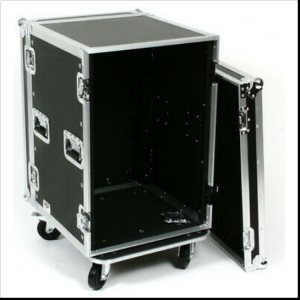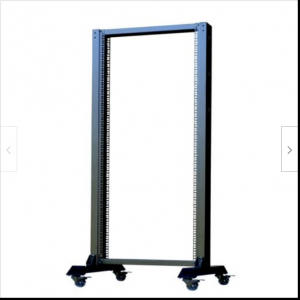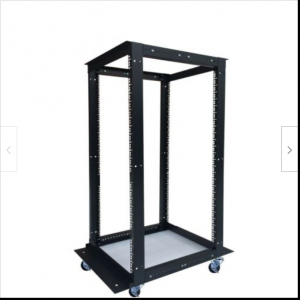Soundproof Server Rack/Acoustic Cabinet Wishlist
While Qubes will be moving to an architecture that allows you to run your AppVMs on remote machines, allowing you to employ an almost thin-client to mainframe-like architecture, when I first moved to Qubes from Gentoo as my daily driving workstation operating system the number of cores and amount of RAM available in a single system became of paramount importance on my human-interfacing edge devices. I had always wanted the reliability and redundancy features of rack mounted servers in my workstation and now an even better reason pushes me in that direction; you can get multi-socket systems just oozing with ECC ram for pennies on the dollar if you are willing to work with datacentre-focused servers that are just a few years older thanks to leasing arrangements, EoL policies and aggressive upgrading.

Having lost my house in the financial upheaval wrought by the COVID pandemic it's no longer a simple matter of running a bundle of actively amplified HDMI and USB cables up from my basement and into my office; if I want to use a rack mounted server or servers as part of my network operations workstation in any apartment I might find myself in while clawing my way back to financial contentment I would need to have them in the same room as me. Even modifying the fans of a typical rack mount server with resistors or throttling them though management interfaces - where that is even possible - still leaves me with a virtual jet engine next to me and this is not an acceptable proposition, especially for tasks that draw upon creative juices. The sound buggers with my chi, one might say.
The solution is to employ a soundproof rack, also called an "acoustic cabinet" but the problem is that the market for them is dominated by three companies and in an industry where brand new hardware is already overinflated in price the lack of competition has allowrd them to keep prices far above reason. Enough so that it makes sense for one to build one's own solution. While you might find it easier to start with an enclosed cabinet and seal its holes they tend to lack the kind of space between the outer panels and inner rack to do add much soundproofing material and more importantly, to construct air ducts that wind in such a way as to muffle sound while still permitting sufficient airflow that a few quiet brushless fans can provide adequate assistance to keep the now-stifled rackspace within optimal operating temperatures.

Enclosed cabinets also tend to cost as much as half the price of their equivalently sized sounfproof options and that negates the savings necessary to make a DIY project like this worthwhile. Therefore I am leaning more toward incorporating a much cheaper open four-post rack into my design. Additionally, since moving again - and maybe again and again - is back in my future until a new house can be secured, mobility is important. I think it makes more sense to trust the selection of casters that a rack manufacturer has selected than to add another problem to my list and as such you will likely find more quater- to half-height racks and cabinets in this, my living list of potential materials that will be incorporated into my eventual work product.
An ATA Case (more commonly known as a "Road Case" or "Flight Case") enclosed rack may in fact provide the ideal starting point as they are designed with casters and substantial padding though not intended specifically for soundproofing and the enclosures are typically free from ventilation holes which otherwise need to be blocked if starting with a conventional enclosed cabinet. Replacing the material between rack and outer enclosure with materials engineered specifically for soundproofing properties may improve performance and would then only necessitate routing ventilation and adding an active ventilation system to ensure proper cooling while the devices are run inside the enclosure. In this context the term "space" is usually used instead of [rack] unit for the 1 1/4 inch standard equipment size unit and the depth of such cases are often expressed in spaces the same as their rack capacity, such that a 14 space rack in a case that is 14 spaces deep has installable dimensions of 24.5 (14*1.75) inches high by 24.5 inches deep with a width sufficient to accommodate "19-inch rack"-able equipment (approximately 17-17.5").
When (and if) finished you can expect a follow-up article, until then please enjoy and hopefully benefit from my brainstorming, note-taking and research as it grows below:
Notes
- Though you will see pyramidal foam in professional cabinets this is mostly designed to absorb echo and high frequency sounds for improving recordings. A thin layer innermost facing the servers might be appropriate
- An air cavity between layers of soundproofing material (any material) greatly increases efficacy and would make pyramidal foam as mentioned above much more useful than for its largely cosmetic effect
- Bituminous foil applies a layer of this petro industrial product to aluminum or other metallic foil and was developed for the roofing profession before its excellent sound deadening properties were discovered.
- Mass Loaded Vinyl is an extremely dense substance that provides excellent sound absorption and at least one layer should form the outermost soundproofing material layer in a soundproof enclosure.
Items
- "Green Glue" noiseproofing adhesive compound https://www.amazon.ca/s?k=green+glue&crid=15E5MY1E1MZNN&sprefix=green+glue%2Caps%2C621&ref=nb_sb_noss_1
- Mass Loading Vinyl https://www.amazon.ca/s?k=soundproofing+mass+loaded+vinyl&crid=174LAHTGBC8OT&sprefix=soundproofing+mass+loaded+vinyl%2Caps%2C134&ref=nb_sb_noss
- Bituminous Foil https://www.google.com/search?q=bituminous+foil
- 18U 2 post [relay] open rack with quad casters @ ~CAD$89.39 ea ~CAD$88.33 shipping from Lasalle QChttps://www.ebay.ca/itm/112601020197 easily adjustible width, add four steel beams of custom length and connect horizontally. Likely to provide excellent stability and weight distribution due to quad caster base on each end.

2-Post ("Relay") Rack - 27U 4 post [server] open rack with casters @ ~CAS$235 ea ~CAD$37.04 shipping from Montreal QC https://www.ebay.ca/itm/184899201272, ~CAD$285 free shipping with Best Offer option shipped from same location https://www.ebay.ca/itm/184681026572 requires additional steel and custom bolt holes to extend to sufficient length if we want the back casters to line up with the back of the enclosure however it might provide better support for the actual weight inside depending on the depths of devices actually installed if it is kept at initial dimensions.

4 Post ("Server") Rack - Rubberized (vehicular) undercoating spray for those nooks and crannies
- PlastiDip only makes sense if undercoating spray works
Links
- https://soundproofguide.com/how-to-soundproof-a-server-rack-easy-cheap-diy/
- https://soundproofcentral.com/diy-soundproof-server-rack/
Video

Comments
There are no comments for this item.